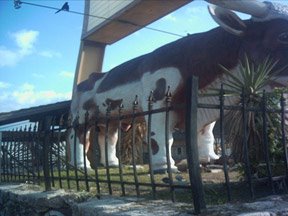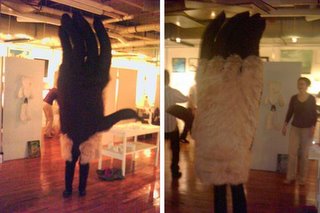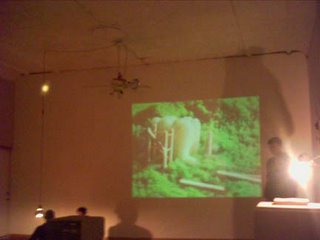I just came across this today while browsing an indymedia web site:
http://www.indymedia.org.uk/media/2004/01/284087.mpg
this is text from the indymedia site:
This video has caused a great deal of controversy. Originally shown on ABC TV, it was first shown as an object lesson as to what happens to Iraqi Insurgents who dare show weapons before US forces. However, as time goes on, doubt has begun to surface as to whether the people shown blown to pieces with the 30mm cannon on the Apache were really insurgents, or just harmless farmers.
This is what is known about the tape. It is from the thermographic camera system of an Apache attack helicopter. The image is of heat, not of light. The time of day appears to be midmorning, based on the time display seen on the heads-up display. Military time uses a 24 hour system, there is no "PM" in military clocks.
The vehicle at the far left of the video is a farm tractor, facing away. The engine is running as is evidenced by the hot vertical exhaust tupe and the glowing undercarriage seen in the thermal image. Attached to the rear of the tractor is a plough, and the dirt in the foreground shows clear furrows.
There is a longer version of the tape (which may not play on everyone's computers) that does show one individual taking a long object or objects from his car and taking it over to the vehicle at the far right. It is assumed by those who want to justify the shooting that this object is a missile launcher assembly being discarded. However, one cannot explain why someone who had just fired off an RPG at US troops would bother to put the used launcher into his car, only to them drive someplace else and then discard it. Nor does it make sense that the man would place a weapon over there it is likely to be run over by the tractor and plough, damaging both the weapon and the plough assembly as well. And, given that the man does not in any way point the object at the approaching helicopter, it is clear that at least he does not think it is a working weapon. Given that the object is actually longer than an RPG launcher assembly, three alternative explanations suggest themselves.
1. That the object is a bundle of long handled farm tools being taken over to where the farmers are working with the tractor.
2. That the object is a bundle of thin poles to be driven into the ground ahead of the tractor to give the tractor driver a visible guide to keep the furrows straight.
3. As suggested by a reader, that the object may be part of the plastic pipe irrigation system used in dry climate agriculture.
We can deduce several facts from the video.
From the perspective seen in the video, it is clear that the Apache helicopter is not being threatened. It is hovering, moving slowly forward, and not engaging in any evasive maneuvers which would suggest that the individuals on the ground have threatened the apache in any way.
From the body language of the individuals on the ground, it is clear that they themselves do not feel they are doing anything which should be of concern to a US helicopter hovering nearby. In other words, they do not act like the object thrown into the field near the tractor is anything the US helicopter would object to. No sooner has the man delivered the object to the tractor than he turns and walks back to the car. At no time does he (or anyone else) act like they are trying to escape the area until the Apache opens fire.
From The Geneva Convention 3-1: 1. Persons taking no active part in the hostilities, including members of armed forces who have laid down their arms and those placed hors de combat by sickness, wounds, detention, or any other cause, shall in all circumstances be treated humanely, without any adverse distinction founded on race, colour, religion or faith, sex, birth or wealth, or any other similar criteria
The very FIRST person gunned down was the person who had been driving the tractor. This video records a war crime.
http://www.whatreallyhappened.com/
Friday, November 25, 2005
Thursday, November 24, 2005
No Thanks to Thanksgiving
No Thanks to Thanksgiving
By Robert Jensen, AlterNet.
Posted November 23, 2005.
One indication of moral progress in the United States would be the replacement of Thanksgiving Day and its self-indulgent family feasting with a National Day of Atonement accompanied by a self-reflective collective fasting.
In fact, indigenous people have offered such a model; since 1970 they have marked the fourth Thursday of November as a Day of Mourning in a spiritual/political ceremony on Coles Hill overlooking Plymouth Rock, Massachusetts, one of the early sites of the European invasion of the Americas.
Not only is the thought of such a change in this white-supremacist holiday impossible to imagine, but the very mention of the idea sends most Americans into apoplectic fits -- which speaks volumes about our historical hypocrisy and its relation to the contemporary politics of empire in the United States.
That the world's great powers achieved "greatness" through criminal brutality on a grand scale is not news, of course. That those same societies are reluctant to highlight this history of barbarism also is predictable.
But in the United States, this reluctance to acknowledge our original sin -- the genocide of indigenous people -- is of special importance today. It's now routine -- even among conservative commentators -- to describe the United States as an empire, so long as everyone understands we are an inherently benevolent one. Because all our history contradicts that claim, history must be twisted and tortured to serve the purposes of the powerful.
One vehicle for taming history is various patriotic holidays, with Thanksgiving at the heart of U.S. myth-building. From an early age, we Americans hear a story about the hearty Pilgrims, whose search for freedom took them from England to Massachusetts. There, aided by the friendly Wampanoag Indians, they survived in a new and harsh environment, leading to a harvest feast in 1621 following the Pilgrims first winter.
Some aspects of the conventional story are true enough. But it's also true that by 1637 Massachusetts Gov. John Winthrop was proclaiming a thanksgiving for the successful massacre of hundreds of Pequot Indian men, women and children, part of the long and bloody process of opening up additional land to the English invaders. The pattern would repeat itself across the continent until between 95 and 99 percent of American Indians had been exterminated and the rest were left to assimilate into white society or die off on reservations, out of the view of polite society.
Simply put: Thanksgiving is the day when the dominant white culture (and, sadly, most of the rest of the non-white but non-indigenous population) celebrates the beginning of a genocide that was, in fact, blessed by the men we hold up as our heroic founding fathers. The first president, George Washington, in 1783 said he preferred buying Indians' land rather than driving them off it because that was like driving "wild beasts" from the forest. He compared Indians to wolves, "both being beasts of prey, tho' they differ in shape."
Thomas Jefferson -- president #3 and author of the Declaration of Independence, which refers to Indians as the "merciless Indian Savages" -- was known to romanticize Indians and their culture, but that didn't stop him in 1807 from writing to his secretary of war that in a coming conflict with certain tribes, "[W]e shall destroy all of them."
As the genocide was winding down in the early 20th century, Theodore Roosevelt (president #26) defended the expansion of whites across the continent as an inevitable process "due solely to the power of the mighty civilized races which have not lost the fighting instinct, and which by their expansion are gradually bringing peace into the red wastes where the barbarian peoples of the world hold sway."
Roosevelt also once said, "I don't go so far as to think that the only good Indians are dead Indians, but I believe nine out of ten are, and I shouldn't like to inquire too closely into the case of the tenth."
How does a country deal with the fact that some of its most revered historical figures had certain moral values and political views virtually identical to Nazis? Here's how "respectable" politicians, pundits, and professors play the game: When invoking a grand and glorious aspect of our past, then history is all-important. We are told how crucial it is for people to know history, and there is much hand wringing about the younger generations' lack of knowledge about, and respect for, that history.
In the United States, we hear constantly about the deep wisdom of the founding fathers, the adventurous spirit of the early explorers, the gritty determination of those who "settled" the country -- and about how crucial it is for children to learn these things.
But when one brings into historical discussions any facts and interpretations that contest the celebratory story and make people uncomfortable -- such as the genocide of indigenous people as the foundational act in the creation of the United States -- suddenly the value of history drops precipitously and one is asked, "Why do you insist on dwelling on the past?"
This is the mark of a well-disciplined intellectual class -- one that can extol the importance of knowing history for contemporary citizenship and, at the same time, argue that we shouldn't spend too much time thinking about history.
This off-and-on engagement with history isn't of mere academic interest; as the dominant imperial power of the moment, U.S. elites have a clear stake in the contemporary propaganda value of that history. Obscuring bitter truths about historical crimes helps perpetuate the fantasy of American benevolence, which makes it easier to sell contemporary imperial adventures -- such as the invasion and occupation of Iraq -- as another benevolent action.
Any attempt to complicate this story guarantees hostility from mainstream culture. After raising the barbarism of America's much-revered founding fathers in a lecture, I was once accused of trying to "humble our proud nation" and "undermine young people's faith in our country."
Yes, of course -- that is exactly what I would hope to achieve. We should practice the virtue of humility and avoid the excessive pride that can, when combined with great power, lead to great abuses of power.
History does matter, which is why people in power put so much energy into controlling it. The United States is hardly the only society that has created such mythology. While some historians in Great Britain continue to talk about the benefits that the empire brought to India, political movements in India want to make the mythology of Hindutva into historical fact.
Abuses of history go on in the former empire and the former colony. History can be one of the many ways we create and impose hierarchy, or it can be part of a process of liberation. The truth won't set us free, but the telling of truth at least opens the possibility of freedom.
As Americans sit down on Thanksgiving Day to gorge themselves on the bounty of empire, many will worry about the expansive effects of overeating on their waistlines. We would be better to think about the constricting effects of the day's mythology on our minds.
Robert Jensen is a journalism professor at the University of Texas at Austin, and the author of, most recently, The Heart of Whiteness: Confronting Race, Racism and White Privilege (City Lights, 2005).
Monday, November 14, 2005
Casket Factory 2005
I just got back from Dallas today. I travelled with artist Edra Soto and we had a blast meeting new and interesting people from Texas. We got a glimpse of the contemporary art scene down there. Below are some pics:

Randall from Plush Gallery suggested having lunch at this restaurant near the fair called Raul's with a huge bull sculpture in front. Edra noticed some anatomically correct parts.

Once inside we noticed this office chair. It seemed out of place. I guess they ran out of restaurant chairs.

Edra took a photo of my bag as we were leaving.

Once back at the art fair, Edra did a brief 2 minute dance performance inside this paw/hand looking sculpture/costume.

diet ROCKSTAR Energy Drink...party like the rockstars!!
see more photos here
Friday, November 04, 2005
microtecture
Another great show at polvo tonight!! Huong Ngo and Rob Allen, both from the east coast, were in town to install and for the opening. They created micro installations/environments along with video animations of the objects projected onto one of the walls. You need to really get on the floor and see the miniature environments up close.




Casket Factory
Subscribe to:
Posts (Atom)

